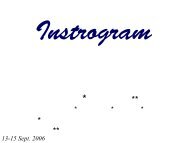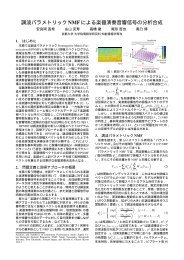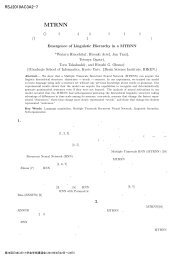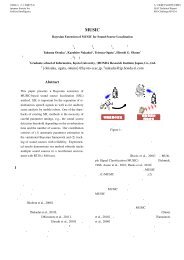第22回 ロボット聴覚特集 - 奥乃研究室 - 京都大学
第22回 ロボット聴覚特集 - 奥乃研究室 - 京都大学
第22回 ロボット聴覚特集 - 奥乃研究室 - 京都大学
Create successful ePaper yourself
Turn your PDF publications into a flip-book with our unique Google optimized e-Paper software.
社 団 法 人 人 工 知 能 学 会Japanese Society forArtificial Intelligence人 工 知 能 学 会JSAI Technical ReportSIG-CHallege-0522-3 (10/14)Blind source separation of many sounds in the frequency domain Hiroshi Sawada, Ryo Mukai, Shoko Araki and Shoji Makino NTT NTT Communication Science Laboratories, NTT Corporation{sawada, ryo, shoko, maki}@cslab.kecl.ntt.co.jpAbstractThis paper describes the frequency-domain approachto the blind source separation (BSS) ofconvolutively mixed acoustic signals. The advantageof the frequency-domain approach is that convolutivemixtures in the time domain can be approximatedas multiple simple mixtures in the frequencydomain. However the permutation ambiguityshould be solved to group the frequency componentsof the same source together. This paperpresents effective methods to align the permutationambiguity. Based on the methods, we succeeded inseparating many sources in real-world situations.1 [1] (BSS: Blind Source Separation [2]) (ICA: Independent Component Analysis [3])BSS ICA ICA ICA [4–6] ICA [7–10]ICA permutation [11–16] permutation 2 2 3 6 3 2 N s 1 (t),...,s N (t) M x 1 (t),...,x M (t) N∑ ∑x j (t) = h jk (l)s k (t − l) (1)k=1 lh jk k j BSS N M N M [16] M 17
















